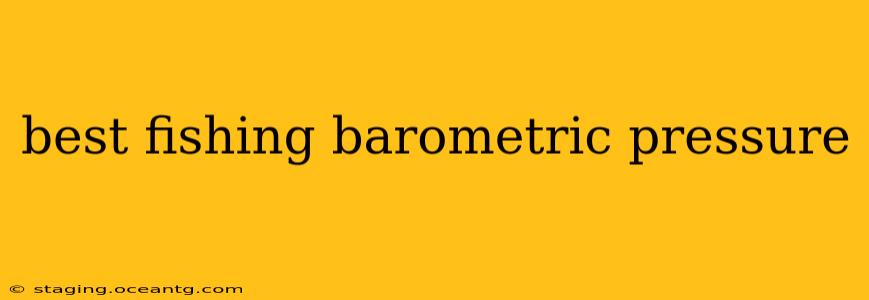Anglers know that a successful fishing trip often hinges on more than just skill and the right bait. Understanding the influence of barometric pressure on fish behavior can significantly improve your chances of a bountiful catch. But what's the best fishing barometric pressure? It's not a single number, but rather a range and a nuanced understanding of how these changes affect aquatic life. This comprehensive guide will explore the relationship between barometric pressure and fish activity, answering your burning questions and helping you plan your next fishing expedition strategically.
What is Barometric Pressure, and Why Does it Affect Fishing?
Barometric pressure, measured in inches of mercury (inHg) or millibars (mbar), represents the weight of the atmosphere pressing down on the Earth's surface. Changes in barometric pressure affect the amount of dissolved oxygen in the water. Fish, like all living creatures, require oxygen to survive. A sudden drop in pressure can reduce oxygen levels, making fish less active and harder to catch. Conversely, stable pressure often correlates with increased fish activity.
What is the Best Barometric Pressure for Fishing?
There's no single "best" barometric pressure for fishing, as it depends on several factors including:
- Species of fish: Different fish species react differently to pressure changes.
- Water temperature: Colder water holds more oxygen, mitigating the effects of low pressure.
- Time of year: Seasonal changes can also influence fish behavior.
- Water depth: Fish in deeper waters might be less affected by surface pressure changes.
Generally, however, many anglers find success fishing during periods of stable barometric pressure. A slow, steady pressure either rising or falling is often better than a rapid change. Many successful fishing days occur when the pressure is between 29.80 and 30.20 inches of mercury (or 1010 and 1020 millibars). However, this is not a hard and fast rule.
What Barometric Pressure Makes Fish Bite Best?
Fish biting behavior is more closely tied to changes in barometric pressure than a specific reading. Many anglers report better fishing during a slow, steady rise in barometric pressure. This is often associated with improving weather conditions. Conversely, a rapid drop in pressure, often preceding a storm, can make fish less active and more difficult to catch.
Does Rising or Falling Barometric Pressure Affect Fishing?
Both rising and falling barometric pressure can affect fishing success, but in different ways:
- Rising Barometric Pressure: Often associated with fair weather and increased dissolved oxygen in the water, leading to more active fish.
- Falling Barometric Pressure: Can precede stormy weather, reducing oxygen levels and potentially making fish less active. They might also seek deeper, more stable waters.
How to Use a Barometer for Fishing?
A barometer, either an analog or digital device, is an invaluable tool for anglers. By monitoring pressure trends, you can anticipate changes in fish behavior and plan your fishing trips accordingly. Look for consistent readings over a few hours, rather than just one snapshot, for a more accurate assessment. Many weather apps also provide barometric pressure readings.
Are there specific times of day that are better for fishing based on barometric pressure?
While barometric pressure plays a crucial role, the time of day also impacts fishing success. Dawn and dusk are often cited as peak feeding times for many fish species, regardless of the barometric pressure. These periods offer lower light levels and may provide fish with better cover from predators while seeking food.
Conclusion: Understanding Barometric Pressure for Better Fishing
Ultimately, the "best" fishing barometric pressure is less about a specific number and more about understanding the trends and how they affect fish behavior in relation to other environmental factors. By incorporating barometric pressure readings into your fishing strategy alongside your knowledge of fish behavior and local conditions, you significantly increase your chances of a successful and rewarding fishing experience. Remember, consistent monitoring and observation are key to maximizing your chances of success.
